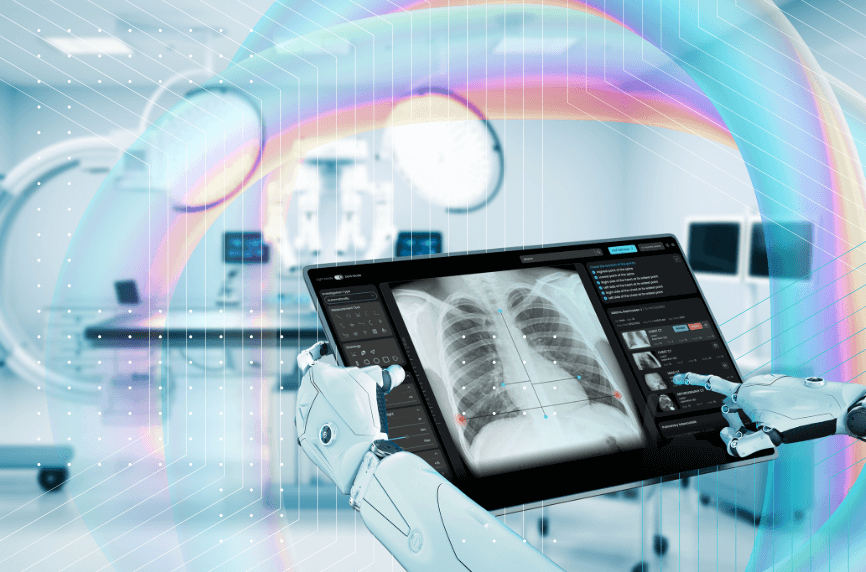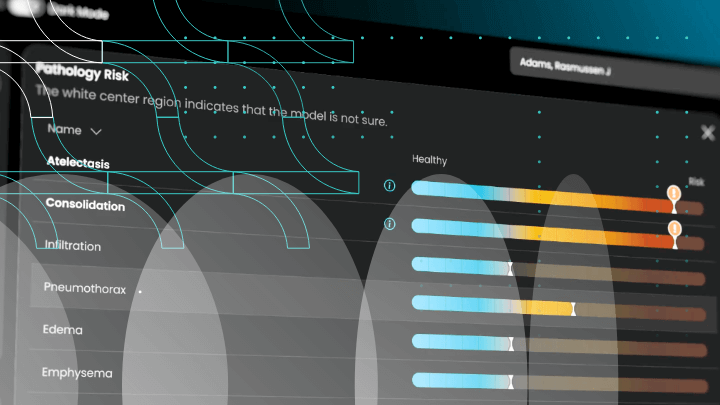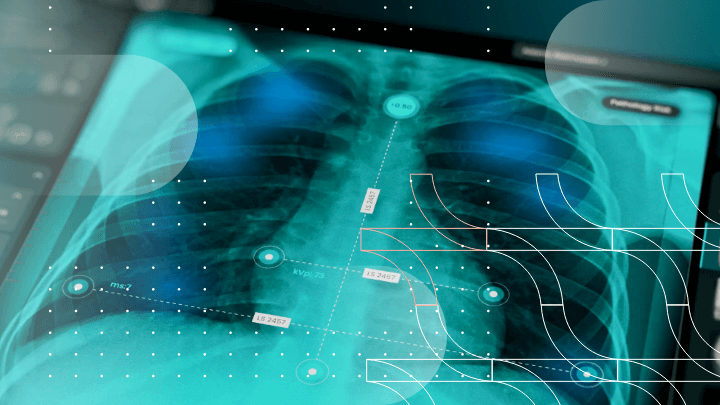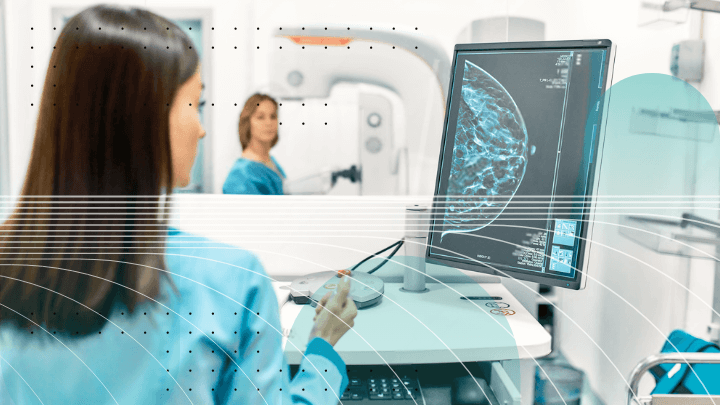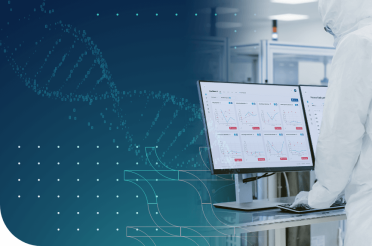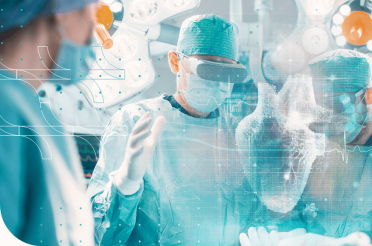Artificial Intelligence (AI) in medical imaging represents a transformative convergence of technology and healthcare. Its integration into medical imaging is not just a technical advancement but a shift that promises to redefine diagnostics and treatment planning.
The significance of AI in healthcare and medical imaging cannot be overstated, as it extends beyond mere improvements in image quality and processing speed. For instance, the field of Radiology, Nuclear Magnetic Resonance, and Medical Imaging (RNMMI) has seen substantial growth in AI and machine learning publications, with an annual growth rate of 29.8% and a doubling time of approximately 2.7 years.
This type of growth is not only unique to the field of radiology, as AI’s capabilities in early disease detection and personalized modern medicine have also become game-changers. It’s not just about faster and clearer images but about saving lives through early intervention and tailored treatment options.
The real-world implications of these advancements are profound, particularly in areas like oncology and neurology where timely and accurate diagnosis is crucial. More specifically, it has been shown to potentially increase the number of patients scanned per day by a significant margin, emphasizing not just improved patient outcomes and safety, but also heightened productivity and cost-effectiveness.
The impact of AI techniques on medical imaging is multifaceted. It’s improving diagnostic accuracy, reducing human errors, and enabling early disease detection, thus elevating the standard of patient care.
This article delves into these aspects, offering a comprehensive overview of the current state and future possibilities of AI in medical imaging technologies.
The potential of AI in medical imaging
AI can be used in lots of different ways when it comes to improving medical imaging, but it’s not always so easy to find the best way to integrate it within your existing system.
Its full potential can be realized by effectively utilizing machine learning and deep learning algorithms that allow you to be flexible with your approach. AI has started to play a pivotal role in enhancing medical imaging techniques, which if used correctly can lead to significant improvements in the following four areas.
One of the most notable aspects is improving the image quality. AI algorithms can analyze vast amounts of imaging data by learning to distinguish subtle patterns and anomalies that would otherwise be invisible to the human eye. The increased resolution and clarity of these images have paved the way for more precise diagnoses like the ability to detect fractures.
The processing speed to produce images is another area where AI is making a substantial impact. Traditionally, analyzing medical images has always been time-consuming and has often created bottlenecks in diagnosis and treatment.
With its ability to quickly process and analyze large datasets, AI is drastically reducing the time needed for medical image analysis. As a result, AI systems can now analyze and create images that are complex, in a fraction of the time it takes for conventional methods, thereby accelerating the diagnostic process.
Next up, by integrating deep learning algorithms, AI can identify patterns associated with specific diseases, making it a valuable tool in early disease detection and diagnosis. Therefore, through advanced image analysis, AI can detect anomalies such as tumors at an early stage and significantly improve the experience of many patients.
For example, in October 2023 Roche, Ibex Medical Analytics, and Amazon Web Services partnered to enhance digital pathology. The collaboration involves integrating Ibex’s AI algorithms with Roche’s navify Digital Pathology software, running on Amazon’s cloud platform. This partnership aims to improve diagnostic processes for breast and prostate cancer, leveraging AI for better workflow efficiency and quicker turnaround in pathology labs.
AI’s role in personalized medicine and preventive healthcare is also a promising avenue. By analyzing imaging data alongside a patient’s medical history, AI can provide personalized diagnostic information, which paves the way for customized treatment plans.
This aspect of AI holds immense potential for managing chronic diseases and conditions, where early detection and tailored treatment plans can make a significant difference.
Current applications of AI in medical imaging
The current applications of AI in medical imaging significantly impact areas like radiology, oncology, and neurology. By leveraging AI, the medical specialists working in these areas can enhance the accuracy and efficiency of many diagnoses and treat medical conditions more successfully.
In radiology for example, AI is predominantly used to identify abnormalities in imaging scans. AI algorithms applied to computed tomography (CT) and magnetic resonance imaging (MRI Images) can rapidly identify and segment areas of interest in lung, liver, and brain scans.
A notable example is the use of AI in detecting pulmonary nodules in chest CT scans. There, AI significantly improves the detection rate of small nodules, which are often missed by the human eye.
AI’s role in oncology imaging is particularly worth mentioning. It assists in detecting and monitoring cancerous growths, which improves the accuracy of breast cancer screenings. For instance, deep learning AI technology was used to analyze mammograms, distinguishing between malignant and benign lesions with high accuracy.
It has become a central repository for the AI-PHI’s mammography studies, which over time will include mammograms from over 5 million women on 5 continents. This AI-driven approach is important in early cancer detection, which significantly impacts patient prognosis.
In neurology, AI is enhancing the analysis of brain images for conditions like stroke, Alzheimer’s disease, and brain tumors. AI algorithms can detect subtle changes in brain tissue, which allows for earlier intervention and treatment. An insightful example is the use of AI in diffusion weighted imaging, a type of MRI, to swiftly identify stroke-affected areas in the brain.
This AI model demonstrated top-notch performance, with a 94.4% area under the curve, in evaluating 6,716 cases from the national lung cancer screening trial. It also maintained similar accuracy in a separate, independent set of 1,139 clinical validation cases.
These three areas show how AI applications in medical imaging are not only enhancing current diagnostic and treatment practices but are also opening new frontiers in personalized medicine. From improving diagnostic accuracy in radiology to aiding in the early detection of cancer cells and neurological conditions, AI is proving to be an invaluable asset in the healthcare industry.
To help you fully understand its capabilities, we need to take a look at its impact on improving diagnostic accuracy.

Discover the specific role of AI in medical imaging for your organization
Learn about the revolution of AI in medical imaging and how to leverage the most recent improvements in algorithms.

The impact of AI on diagnostic accuracy
The integration of artificial intelligence (AI) in medical imaging analysis has markedly improved diagnostic accuracy. It reduces human error, and enhances the detection of diseases at their early stages. This shift towards AI-enhanced diagnostic methods is reshaping the landscape of medical imaging technology and precision medicine.
Firstly, with their ability to learn from vast datasets, AI algorithms have shown a remarkable improvement in identifying and diagnosing medical conditions. For instance, AI can match or even surpass the accuracy of human body radiologists in detecting diseases like pneumonia in chest X-rays. This level of accuracy is particularly crucial in conditions where early detection significantly influences the treatment outcomes of a medical intervention.
The second key benefit of AI in medical imaging is its consistency, which greatly reduces human error. Unlike a human radiologic technologist who may be influenced by fatigue or subjective judgment, AI systems provide consistent analysis. AI assistance can reduce diagnostic errors in breast cancer screening mammograms thereby improving the reliability of diagnoses.
Early detection of diseases is vital for effective treatment, and AI is starting to play a significant role in this area. For example, AI has been instrumental in the early detection of diabetic retinopathy, a condition that can lead to blindness if untreated. AI-based analysis of retinal images could detect this condition with high accuracy, often before patient’s body exhibits any symptoms.
By reducing human error, improving accuracy, and enabling early disease detection, AI is not only enhancing the quality of patient care but also paving the way for advancements in precision medicine.
Advancements in AI technology for medical imaging
The field of medical imaging has seen significant advancements marked by the development of new AI algorithms, enhanced machine learning methods, and improved hardware that supports these innovations. A timeline of these developments reveals the rapid evolution of AI in medical imaging, showcasing how each advancement builds upon the last to create more sophisticated and effective tools.
The early 2010s marked a period of rapid progress in incorporating machine learning techniques into medical imaging. Since then, algorithms have become more sophisticated and capable of handling vast amounts of imaging data with greater precision. In the second half of the 2010s these advancements in AI technology have been supported by simultaneous improvements in hardware.
The development of high-performance GPUs and specialized AI processors has allowed for faster processing of complex algorithms, making real-time analysis of medical image registration feasible. As a result, these hardware advancements have become crucial in supporting the computational needs of advanced AI applications in medical imaging.
Post-2020, AI in medical imaging seeks to integrate deep learning, advanced machine learning techniques, and powerful hardware to provide unprecedented diagnostic accuracy and efficiency. The future looks towards AI models that are not only more accurate but also more interpretable and capable of providing insights into complex medical conditions.
AI Large Language Models are primarily utilized in medical imaging equipment for enhancing diagnostic accuracy, automating the interpretation of medical images, and improving the overall efficiency of diagnostic processes. These models are adept at processing vast datasets, identifying intricate patterns, and providing comprehensive insights, which significantly aid in disease detection and classification.
Challenges in аdopting AI in medical imaging
Despite its numerous benefits, AI integration faces several challenges that are slowing down its widespread adoption by the sector. These challenges range from ethical concerns to technical obstacles, each impacting the healthcare industry in the following ways.
The first challenge that affects AI the most is the concern about data privacy. AI systems require access to vast datasets of patient images, which raises significant privacy concerns.
Ensuring the confidentiality and security of this sensitive data is paramount. Healthcare organizations must adhere to strict data protection regulations, since ensuring the confidentiality and security of this sensitive data is extremely important.
For example, the most common regulation used in the United States of America to safeguard patient information is the Health Insurance Portability and Accountability Act (HIPAA).
The cost of integrating AI into existing standard imaging techniques is another significant barrier. The acquisition of AI software, along with the necessary hardware upgrades, can be prohibitively expensive for many healthcare facilities. This process is especially hard if you are managing a smaller medical practice.
To mitigate this, you could consider working with a healthcare IT services provider like BGO Software that will assist you with the gradual implementation of AI.
For AI to be deployed successfully in medical imaging it also requires specialized training for health care professionals. Radiologists and technicians must be educated on how to interpret AI-generated results and integrate these into their clinical decision-making processes. This need for additional training can be addressed through comprehensive educational programs and workshops to ensure that your healthcare professionals are well-equipped to leverage AI in their practice.
It is also important to note that some medical professionals express skepticism or resistance towards AI. This happens often due to concerns about accuracy or the fear of being replaced by technology. Building trust in AI systems is crucial, which you can achieve through transparent communication about AI’s capabilities and limitations with everyone you’re working with
Lastly, technical challenges such as data integration and algorithm biases also pose significant challenges. Integrating AI with existing healthcare IT systems can be complex and requires seamless interoperability. To combat this, AI systems should be trained on diverse, inclusive datasets and undergo rigorous validation to ensure their accuracy and fairness
Regulatory and legal considerations
The integration of artificial intelligence in medical imaging brings with it a complex web of regulatory and legal considerations. Understanding this legal framework is crucial for both healthcare providers and developers to ensure compliance and protect patient interests.
The first key aspect of the legal framework is the regulation of AI by the Food and Drug Administration (FDA) in the United States. The FDA has been actively involved in setting guidelines for AI in medical imaging, by focusing on ensuring the safety and effectiveness of AI-based diagnostic tools. However, the FDA’s evolving approach to regulating AI in medical imaging highlights the need for clear regulatory pathways for AI applications.
Data protection is another critical legal consideration. With AI systems processing vast amounts of sensitive patient data, compliance with data protection laws like the General Data Protection Regulation (GDPR) in Europe and the Health Insurance Portability and Accountability Act (HIPAA) in the United States is essential. These laws mandate strict guidelines on data handling, storage, and sharing, which ensure patient data privacy and security.
At the beginning of 2024 the Council of the European Union and the European Parliament reached an agreement on the first global regulations for AI, known as the Artificial Intelligence Act. This groundbreaking legislation aims to ensure AI’s safe and lawful use while fostering innovation and trust in the technology. The rules will apply uniformly across all member states, emphasizing high-risk AI systems’ transparent, traceable, and human-centric approach.
The legal landscape surrounding AI in medical imaging is however continuously evolving. New regulations are being proposed, and existing laws are being reinterpreted to accommodate the rapid advancement of AI technologies. Because of that there is an increasing need for balanced policies that foster innovation while ensuring patient safety and data privacy.

Deliver a world-class Healthcare project–with high-skilled, seamlessly integrated IT talent
Learn how from our consultants. We work with clients worldwide.
Integration of AI with traditional medical imaging techniques
The integration of AI with traditional medical imaging techniques has created a synergistic relationship that enhances both the accuracy and the efficiency of diagnostic and invasive procedures. This fusion of AI with established image modalities like computed tomography scans (CT) and magnetic resonance imaging (MRI) is revolutionizing the way medical imaging is performed.
In MRI, AI algorithms can drastically reduce the time required for image reconstruction without compromising image quality. A medical research article in the Journal of Magnetic Resonance Imaging shows how AI-based techniques could accelerate medical imaging procedures, by significantly reducing the scanning time and improving patient throughput.
The integration of AI with traditional imaging techniques creates a synergistic relationship where each complements the other. AI’s capability to analyze vast amounts of imaging data with precision complements the radiologist’s expertise, which leads to more accurate diagnoses and better patient outcomes.
For instance, the use of AI in conjunction with standard ultrasound waves techniques has improved the detection rate of breast and advanced prostate cancer, which showcases the power of this synergistic approach.
Conclusion
To summarize it is important to note that AI’s integration into medical imaging is not just a technical advancement but a shift that promises to redefine diagnostics and treatment planning. The positive effect of AI’s integration into the medical imaging mechanism has reached not only patients, owners of medical practices, and medical professionals but also everyone who wants to have a more efficient and error-free healthcare system in their country.
The deployment of AI and Machine Learning Algorithms is establishing an important trend, making work across various sectors more efficient for professionals. Particularly in the realm of healthcare, the potential of AI in the early detection of diseases and crafting personalized treatment plans has not been fully tapped into yet.
The benefits of AI transcend mere speed and clarity in image processing. Its true value shines when healthcare professionals leverage this rapid analysis to conduct early interventions and create individualized treatment strategies, ultimately saving lives.

Whether you’re a startup, a Fortune 100 company or a government organisation, our team can deliver a solution that works for you.
BGO Software
This refined approach shows AI’s profound influence in enhancing healthcare services, going beyond its technical capabilities to become a pivotal tool in life-saving medical interventions.

